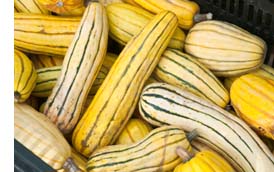In Between Spring and Winter
- By Heidi Lewis
- Reading Time: 2 mins.
By Heidi Lewis
A bounty of winter squash are starting to roll in—a fabulous array of colors, textures, and shapes. Just like the American population, they have an international palette of names, such as turban, Hubbard, Hokkaido, and butternut. Named for outstanding characteristics or in homage—for example, the turban squash mimics the shape of the familiar headdress, and the Hubbard is thought to be named after Elizabeth Hubbard, who purportedly distributed the seeds in the mid-19th century—there are 350 known varieties of squash, falling into two general camps of summer and winter.
 The interesting green-and-tan-striped delicata squash (Italian for “delicate”) is technically a winter squash because of its hard shell. It should be classified as something in-between, like autumn-ish squash, as it has both the soft characteristics of summer and the sweet taste of winter breeds. Delicata is species Cucurbita pepo along with acorn, spaghetti, and carnival squashes.
The interesting green-and-tan-striped delicata squash (Italian for “delicate”) is technically a winter squash because of its hard shell. It should be classified as something in-between, like autumn-ish squash, as it has both the soft characteristics of summer and the sweet taste of winter breeds. Delicata is species Cucurbita pepo along with acorn, spaghetti, and carnival squashes.
Delicata is an heirloom variety also known as Bohemian squash—the name gives away a bit of its history. It was initially introduced by the Peter Henderson Company of New York City in 1894 and was a popular squash through the 1920s. Mr. Henderson provided seeds and literature about gardening for the market from his five-acre, glass-covered greenhouse in Jersey City, NJ. In light of the name Bohemian or delicata, it’s interesting to note that from 1880–1910, the population of New York City was at least 40% immigrants, many from Central and Southern Europe.
One cup of this squash has 1.7 grams of fiber, 1 gram of protein, and only 40 calories. That’s not counting the butter. Delicatas come from a prominent American family—enjoy their bounty.
Want fruit for your office?
Get your office a free sample TODAY!Preparation
Truly delicate for winter squash, delicatas can be peeled (or not!) and sliced or cubed. Steamed, baked, or broiled with a complement of curry, apples, or maple syrup make excellent, warming dishes.
Storage
Delicata store well in a cool, dry (preferably dark) place for a few weeks, but unlike true winter squash, they don’t convert starch to sugar over time and “cure” like butternuts, and will therefore not keep as long.


